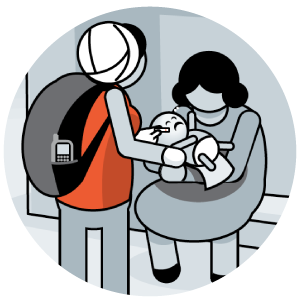Top 5 myths about CHWs…and why they are wrong

Sometimes we hear people say something like: “Community Health Workers are an expensive, unreliable way to fill gaps in rural health care coverage.” Have you ever heard that?
The 1mCHW Campaign promotes the effective use of community health workers (CHWs) in achieving universal health coverage, and works to increase knowledge about the importance of CHWs in the post-2015 development agenda. As part of this advocacy, the Campaign urges financing organizations to support CHWs, and tries to motivate countries to demand this support from donors. However, not everyone agrees that CHWs are effective or sustainable. Let’s take a look at some common myths.
MYTH #1: CHWs are expensive
FACT: Many believe that CHWs are an expensive fix for local health issues, as they need to be trained, compensated, and given supplies. But more than the total cost, we need to look at what we get in return for our investments in CHWs. Evidence shows that CHWs are extremely cost-effective, compared to alternate service delivery models (such as facility-based care) or compared to no care at all, if CHWs are reaching areas that otherwise lack access to the health system and can sustain over time the efforts. There is already tremendous consensus around optimizing financial inputs to maximize on health impact, such as the arguments in the Center for Global Development’s recent publication, “More Health for the Money,” which include clear recommendations for the Global Fund. Utilizing cost-effective health interventions, including CHWs, is far preferable to using only cheap interventions.
MYTH #2: CHWs are unable to collect data
FACT: Some critics argue that CHWs don’t gather data, or that their data is not of high quality, and are thus unable to report outcomes. There has been a recent push, however, to emphasize evidence-based and data driven programs, in both CHW management and service delivery. This study, for example, demonstrates that CHWs are effective in gathering accurate and reliable data, especially in poor settings where other approaches to data collection are infeasible. The development and dissemination of mHealth tools can also ensure that CHWs collect high quality data.
MYTH #3: CHWs are unreliable
FACT: With a lack of infrastructure for accountability, organizations may disburse resources to partners in charge of overseeing CHWs. Unfortunately, in some situations these organizations and their CHWs “drop off the map”, so to speak. This is often due to the remote rural settings where CHWs live and work, and a lack of sufficient communication systems to aid CHWs and their parent organizations to keep in constant contact. However, this trend is declining given improvements in monitoring and evaluation (M&E). M&E ensures accountability by tracking CHW activities to ensure that they are performing as expected. Even greater success can come when CHWs are fully integrated into public health systems. An excellent example of this is Rwanda’s CHW program, which has integrated CHWs into the health system through the innovative use of regulated CHW cooperatives and performance-based financing (PBF).
MYTH #4: CHWs are untrained or under-qualified
FACT: Critics of CHWs claim that they are inexperienced and don’t have the necessary qualifications to address the health needs of hard-to-reach communities, in sub Saharan Africa or elsewhere. In reality, CHWs with minimal qualifications have had remarkable impacts on their communities, such as improving child survival. Strong training programs, like this one from The Open University, teach CHWs the technical skills necessary to be successful lay health providers through practical and experience-based learning. Some of the most effective training programs use testing and self-evaluations to assess how well CHWs retain their trainings, and offer periodic refresher courses to ensure that their knowledge stays up-to-date. When training occurs close to home, as opposed to at a centralized location, it can be tailored to local needs so that CHWs are maximally prepared to handle the health issues that arise in their own communities.
MYTH #5: CHWs are merely a Band-Aid for broken health systems
FACT: The 1mCHW Campaign defines CHWs as a crucial link in the broader primary health care chain. Critics sometimes view CHWs as a short-term stopgap measure in countries with weak primary health systems, instead of as critical components of every successful health care delivery network. But CHWs are recognized as being just as effective in higher-income countries with large internal inequality (like the United States) as they are in lower-income settings. So CHWs should no longer be seen as merely a temporary solution or a stepping-stone on the way to a more ‘sophisticated’ (tertiary-care focused) distribution of human resources for health.
As you’ve seen, these myths are grounded in misinformation or poor evidence, and it is our job to communicate the reality about the amazing potential that CHWs represent – and ensure that they get the support they deserve, especially with regards to financing. In light of the recent joint statement by UNICEF and the Global Fund, investment in CHWs as the delivery platform for integrated community case management (iCCM) is well justified!
Have you heard other myths about CHWs? Do you have answers or solutions to overcome those? Post them below!
Special thanks to Cyril Pervilhac for his thoughtful contributions to this post.

Comments are closed